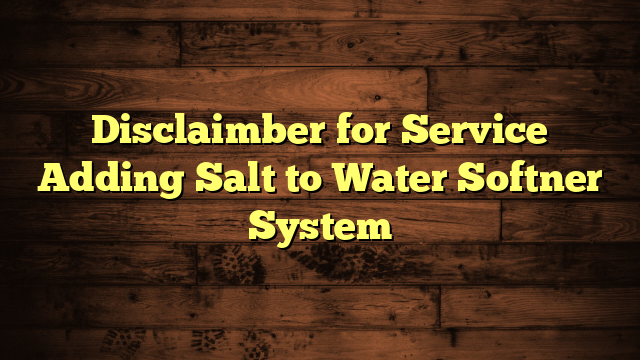How to Build a Three Way Water Softner Bypass?
Imagine standing in front of your water softener, the hum of machinery surrounding you, as you prepare to tackle an essential upgrade. You're about to build a three-way bypass that can save you time and headaches during maintenance. But before you grab your tools, you need to guarantee you've got a solid plan in place. What materials will you need, and how will you execute the installation to prevent leaks? Understanding these details can make all the difference in achieving a smooth, efficient system.
Key Takeaways
- Gather necessary tools and materials, including a pipe cutter, wrench, Teflon tape, and a three-way valve before starting the installation.
- Shut off the water supply, drain the softener, and cut existing pipes at the planned installation site for the bypass valve.
- Install the three-way valve securely, ensuring the correct flow direction and proper alignment of pipes to prevent leaks.
- Gradually turn the water supply back on, checking for leaks and testing the bypass functionality by opening a faucet.
- Conduct regular maintenance checks and testing of the bypass system to ensure optimal performance and address any issues promptly.
Understanding Water Softener Bypass
Understanding water softener bypass is essential for homeowners dealing with hard water issues. When you have hard water, your appliances can suffer from mineral buildup, impacting their longevity and efficiency. A water softener helps to improve your water quality by removing these minerals, but there are times when you might want to bypass the softener. This could be necessary for maintenance, repairs, or if you need to use untreated water for specific applications.
There are various softener types, including salt-based and salt-free systems, each with its own method of operation. Knowing how to bypass your softener allows you to temporarily divert water away from the softening process without disrupting your daily activities.
By understanding the bypass valve, you can guarantee that you're not compromising your home's water quality while still having access to necessary untreated water.
When you learn how to build a water softener bypass, you gain more control over your water system. This knowledge empowers you to maintain your home effectively, guaranteeing that you can manage hard water issues without hassle.
It's all about making informed decisions to keep your water quality high and your appliances running smoothly.
Tools and Materials Needed
To build a water softener bypass, you'll need a few essential tools and materials to guarantee the process goes smoothly. First, gather a pipe cutter, wrench, and Teflon tape. These will help you cut and connect pipes securely.
You'll also need a three-way valve, which is vital for effective valve selection depending on the types of bypasses you may choose to implement.
In addition to the valve, have some flexible tubing or additional PVC pipes on hand, as they might be necessary for proper routing of the water flow.
Don't forget to stock up on appropriate fittings and connectors; these will make certain a watertight seal and prevent leaks.
A bucket is also handy for catching any residual water during the installation process.
Finally, consider having a plumber's tape measure to make sure you're cutting lengths accurately.
Planning Your Bypass Design
With your tools and materials ready, it's time to plan your bypass design. This step is essential because taking the time to map out your approach now can save you headaches later.
You'll want to take into account various design considerations and layout options to guarantee everything functions smoothly.
Here are three important aspects to think about:
- Flow Direction: Determine how water will flow through your system. The bypass should enable water to circulate properly when the softener is disengaged.
- Space Availability: Assess the physical space around your water softener. You'll need enough room to work comfortably and access all parts of the system easily.
- Accessibility: Plan for easy access to the bypass valve. You want to make certain that you can reach it without hassle for future maintenance or adjustments.
Shutting Off Water Supply
Before you start building your water softener bypass, you need to shut off the water supply.
First, locate your main water valve—it's often found near where the water line enters your home.
Remember to take safety precautions, like using a towel to catch any spills, so you can work without any surprises.
Locate Main Water Valve
Finding the main water valve is essential when shutting off your water supply for a softener bypass. Without locating this vital component, you risk flooding or creating a mess during your project.
Start by using the following valve identification techniques to help you find the main valve locations in your home:
- Check the Basement or Crawl Space: Look near where the water line enters your home. The main valve is often located here, typically on the wall closest to the street.
- Inspect the Exterior: If you don't find it inside, check outside your home. Look for a valve near the foundation, often in a box covered with a lid.
- Consult Your Water Company: If you're still unsure, contact your local water company. They can provide guidance on where to find your main valve based on your home's layout.
Once you've located the valve, you'll be better prepared to shut off the water supply, allowing you to proceed safely with the softener bypass installation.
Shut Off Method
When you're ready to install a water softener bypass, shutting off the water supply is crucial to prevent any unwanted leaks or water damage.
Start by identifying the main shut-off valve, which is usually located near your water meter or where the water line enters your home. Familiarize yourself with various valve types, such as gate valves and ball valves, as they require different shut off techniques.
If you have a gate valve, turn the handle clockwise until it stops. For a ball valve, simply rotate the lever perpendicular to the pipe.
After shutting off the main supply, open a faucet at the highest point in your home to relieve pressure. This step guarantees that any remaining water in the pipes drains out, minimizing spills during your installation.
Once you've successfully shut off the water, double-check your connections. If you're working on a water line that has multiple branches, consider using additional shut-off valves to isolate those areas.
This approach provides more control and reduces the risk of leaks in other parts of your plumbing system. By following these steps, you'll be well-prepared for the next phase of your water softener bypass installation.
Safety Precautions Required
It's important to prioritize safety every time you shut off the water supply for your water softener installation. Neglecting safety can lead to accidents or damage, so taking the right precautions is essential.
Here are three key safety tips to follow:
- Wear Personal Protective Equipment (PPE): Before you start, put on gloves and safety goggles. This protects you from possible water splashes or debris.
- Turn Off Electrical Supply: If your water softener is connected to an electrical source, turn it off first. This prevents any electrical hazards while you work on the water supply.
- Know Your Emergency Procedures: Familiarize yourself with emergency procedures in case something goes wrong. Whether it's a sudden leak or equipment failure, knowing how to respond can save you time and prevent further issues.
Installing the Bypass Valve
Now that you've shut off the water supply, it's time to focus on installing the bypass valve.
You'll need a few tools to make the process smooth, and I'll guide you through each step to guarantee a successful installation.
Plus, I'll share some maintenance tips to keep your bypass functioning well for years to come.
Tools Required for Installation
To successfully install a bypass valve for your water softener, you'll need a few essential tools. Having the right equipment makes all the difference, especially when it comes to mastering installation techniques and understanding various bypass configurations.
Here's what you'll need:
- Pipe Wrench: This tool helps you grip and turn the pipes securely, ensuring a tight fit while preventing leaks.
- Teflon Tape: Use this to seal threaded connections. It's vital for achieving a watertight seal, which is important for maintaining peak water softener function.
- Screwdriver Set: A variety of screwdrivers will be necessary for securing the bypass valve and any additional components you'll be working with.
With these tools in hand, you'll be well-equipped to tackle the installation process.
Remember, taking the time to gather your tools beforehand won't only streamline your work but also help you avoid unnecessary trips to the hardware store.
Once you have everything ready, you'll find that the installation of your bypass valve is straightforward and manageable, setting you up for success in your water softening system.
Step-by-Step Installation Process
Installing a bypass valve for your water softener is a straightforward process that can greatly enhance your system's flexibility. First, choose the right bypass valve type for your setup. Three-way valves are popular because they allow for efficient water flow management, enabling you to divert water around the softener as needed.
Begin by shutting off the water supply to your softener and draining any remaining water in the system. Next, cut the existing pipes where you plan to install the bypass valve. Make sure you leave enough room for proper installation.
Now, attach the bypass valve, making certain to follow the manufacturer's instructions closely, as water flow considerations are vital for best performance. Secure the connections using appropriate fittings and check for leaks.
Once everything's in place, turn the water supply back on gradually, allowing the system to fill while observing for any leaks. If everything looks good, test the bypass function to verify water can flow freely around the softener when needed.
This installation not only protects your unit during maintenance but also enhances your overall water quality management.
Maintenance Tips for Bypass
Proper maintenance of your bypass valve is essential for ensuring its longevity and reliable performance.
By keeping it in good working condition, you can avoid costly repairs or replacements down the line. Implementing a few simple practices will make a significant difference.
Here are three essential tips for effective bypass valve maintenance:
- Regular Inspection: Check the valve for any signs of wear, leaks, or corrosion every month. This proactive approach can help catch potential issues early.
- Lubrication: Apply a silicone-based lubricant to the valve's moving parts every six months. This keeps it functioning smoothly and prevents sticking.
- Clean the Valve: Periodically clean the valve's exterior and the surrounding area. Accumulated dirt or debris can affect its performance over time.
Connecting Pipes Correctly
Make certain your pipes are connected securely to create an effective bypass for your water softener. Proper pipe alignment is essential. Start by ensuring each pipe fits snugly into the connectors. Use Teflon tape or pipe joint compound on threaded joints to enhance the seal and prevent leaks.
When connecting the pipes, align them carefully to avoid unnecessary stress on the fittings. Misalignment can lead to leaks over time, which can cause water damage and increase maintenance costs.
After fitting the pipes, double-check each connection. If you notice any gaps or unevenness, adjust the pipes until everything sits evenly. Tighten the fittings, but don't overdo it—too much torque can damage the threads and lead to leaks.
Once you've secured all connections, you're well on your way to ensuring a dependable bypass system. Remember, a well-constructed bypass not only improves the efficiency of your water softener but also prolongs its lifespan.
Taking these extra steps will give you peace of mind, knowing that your plumbing is correctly set up for maximum performance.
Testing the Bypass System
After you've secured all connections, it's crucial to test the bypass system to confirm everything is functioning correctly. Proper testing guarantees your bypass functionality is on point and your system performance meets expectations.
Here's how to do it effectively:
- Check for Leaks: Turn on the water supply and closely inspect all joints and connections. If you see any leaks, tighten the fittings or replace faulty parts.
- Evaluate Water Flow: Open a faucet to assess the water flow. The water should run smoothly without interruptions, indicating that the bypass is correctly diverting water around the softener.
- Monitor Water Quality: Test the water hardness before and after the bypass. Use a hardness test kit to confirm your bypass system is doing its job when needed.
Maintenance Tips for Longevity
A well-maintained water softener bypass can greatly extend the lifespan of your system. To keep everything running smoothly, make it a habit to perform regular inspections. Check for leaks, inspect the valves, and confirm there are no obstructions in the pipes.
These simple steps can help you catch potential issues before they become major problems.
Another key aspect of maintenance is to replace seals when necessary. Over time, seals can wear out, leading to leaks or reduced efficiency. By proactively replacing seals, you can prevent water loss and maintain the performance of your bypass system.
Don't forget to clean the bypass system periodically. Mineral buildup can occur, so flushing the system with vinegar or a recommended cleaner can help.
Also, consider checking the bypass valve's functionality to confirm it's operating correctly.
Lastly, keep an eye on the overall condition of your water softener. If you notice any unusual sounds or changes in water quality, it's time to investigate further.
Frequently Asked Questions
Can I Install a Bypass Valve on Any Water Softener Model?
You can install a bypass valve on many water softener models, but compatibility varies. Check your model's specifications and choose the correct bypass valve types to guarantee smooth installation and proper functionality.
What Are Signs of a Failing Water Softener?
When your water's feeling like a rough ocean, it's time to worry. Signs of a failing water softener include cloudy water, salty taste, or scale buildup. Regular maintenance tips can help keep your water quality smooth and invigorating.
How Often Should I Test the Water After Bypass Installation?
After installing a bypass, you should test the water quality every month for the first three months. After that, adjust the test frequency based on any noticeable changes in water clarity or hardness.
Will a Bypass Affect My Home's Water Pressure?
Yes, a bypass can affect your home's water pressure. If it's not properly installed, you might experience plumbing issues. Regular maintenance and adjustments can help guarantee your water pressure remains consistent and efficient.
Can I Use PVC Pipes for the Bypass Connection?
Yes, you can use PVC pipes for the bypass connection. PVC fittings offer excellent durability, guaranteeing a reliable setup. Just make certain to choose the right size and verify secure connections for peak performance.
Conclusion
Now that you know how to build a three-way water softener bypass, why not take the plunge and enhance your water quality management? By following these steps, you can guarantee smooth operation and longevity for your system. Remember, proper installation and maintenance are key to avoiding future headaches. So, gather your tools, get started, and enjoy the benefits of softened water without any hassle. Your home—and your plumbing—will thank you for it!







